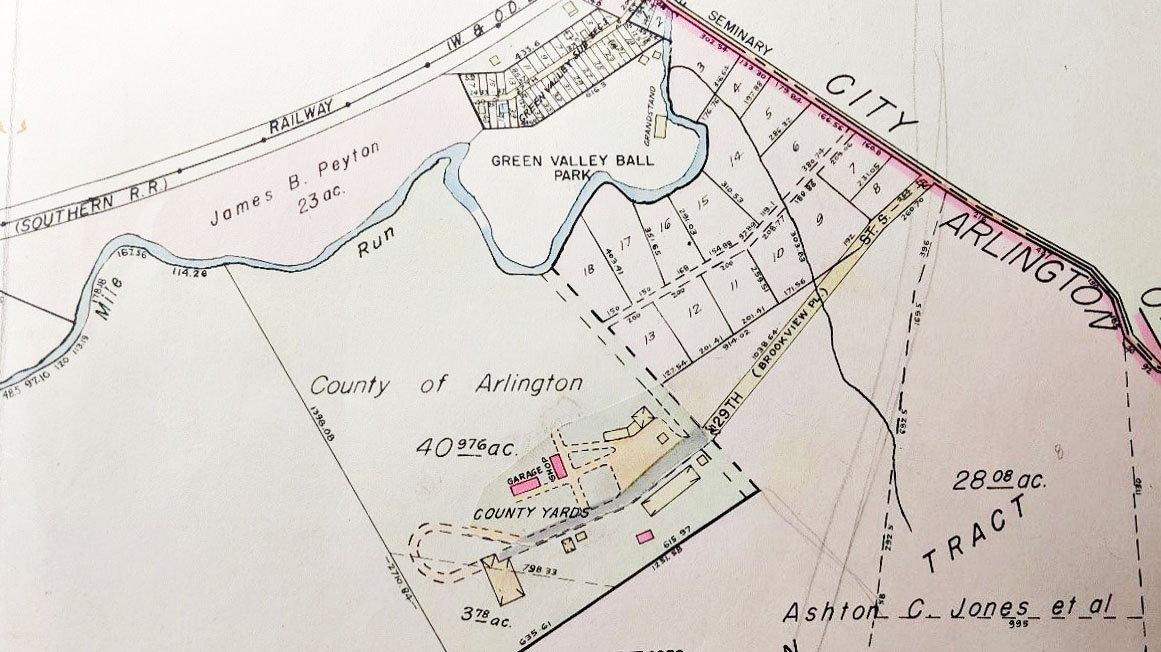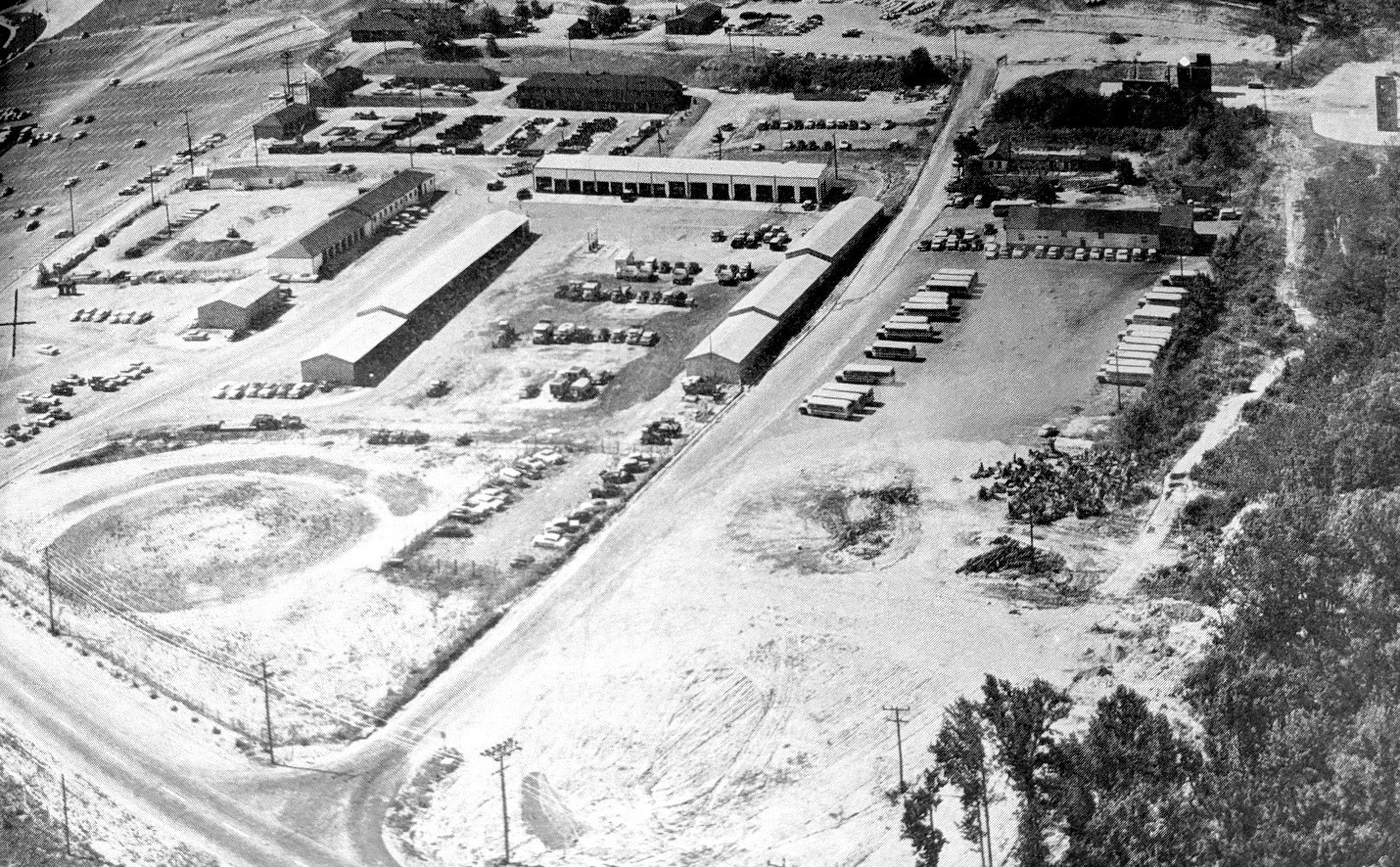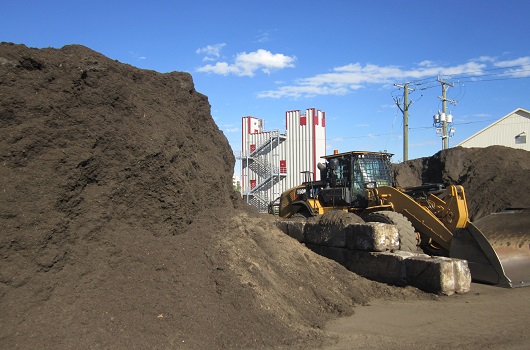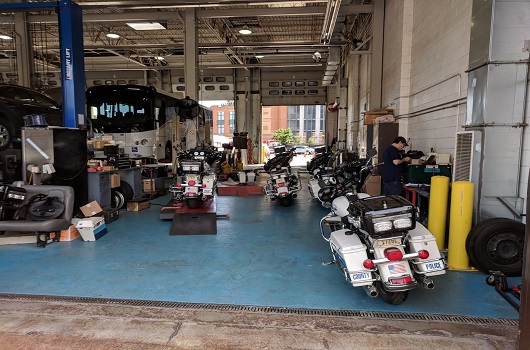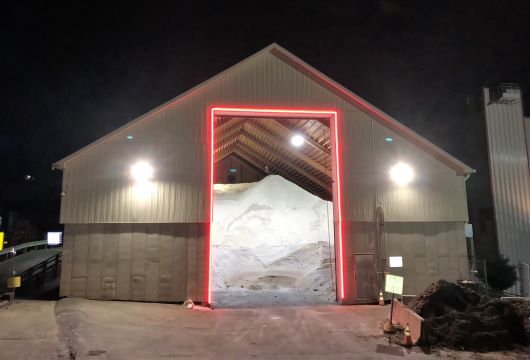Real Estate, Race, Fraud, Politics and Equipment Sheds
Up until the early-1900s, Arlington County stored its essential facilities equipment, which at that time consisted of donkeys and wagons, behind the County Courthouse building, a beautiful Richardsonian Romanesque-styled building.
But by 1925, in response to a relocation order by Virginia Attorney General William C. Gloth, the Board of Supervisors (precursor to the County Board) began actively searching for a new, permanent Property Yard location.
Trades Center, circa 1950s. Image courtesy of Arlington County Government.
Race and Geography
In August 1925 the County purchased a 4.26-acre tract in Fort Myer Heights near the present-day intersection of Fairfax Drive and North Rhodes Street, from Charles A. Douglas, which it still owns today. The Board planned to beautify the new storage area with green lawns and flower beds to create a welcoming public space once the County relocated its equipment.
But by the 1920s, the targeted subdivision had developed into a largely segregated white streetcar suburb, and there was considerable public opposition to the County’s plan. More than 50 people attended a public meeting to protest relocating the Property Yard to this site.
Prominent white local developer Frank Lyon spoke on behalf of those assembled and argued for the development of a public park instead. Lyon owned the weekly newspaper The Monitor and had developed more than 465 acres (almost 3%) of Arlington’s land, routinely including restrictive racial and religious covenants in his deeds of the subdivision. The Board responded by agreeing to put the Fort Myer Heights parcel to another public use and continuing to evaluate potential sites for the Property Yard.
On August 9, 1926, the County purchased an approximately 41-acre parcel from Ashton C. Jones (also known for developing neighborhoods with white-only deed restrictions), Margaret V. Jones, E. Wade Ball, and Maude L. Ball across Four Mile Run, adjacent to the historically black Green Valley community.
The Four Mile Run vicinity tended toward commercial and industrial use, so the move to place the Property Yard here was a natural one. However, the fact that the County moved its project from a historically white area to a historically black area after pressure from the community is indicative of the outsized social power that white residents exercised in local politics.
Scandal in the Treasurer's Office
At the time of the land purchase, E. Wade Ball had been Arlington County’s Treasurer since 1906. Six years later, he was discovered to have been inflating the County accounts to increase his commission, leaving Arlington with only $7,000 in assets instead of the reported $419,000. Ball served 2 1/2 years in federal prison before taking up a career in local real estate.
Arlington County Property Yard, 1935. Pink markings indicate brick buildings and yellow indicates frame building. Visible in the top left is James B. Peyton’s land, including the land he allowed for use as the Green Valley Ball Park.
Development on Four Mile Run
The first buildings and storage structures at the Property Yard included a garage, workshop, stable, and office building. In order to move most of the County’s Water Works to the Property Yard from the Lyonhurst Water Works in North Arlington, in 1938 the County Board voted to enlarge the Property Yard’s storage and services.
The Property Yard continued to expand alongside the boom in Arlington’s suburban development during and after World War II. By the end of the 1940s it housed an underground fuel storage tank, facilities for the Department of Public Service’s Equipment Division, the County’s Water Works and the School Board. The County had also approved the construction of a new building, paid for by the Animal Welfare League, to replace the dog pound.
Bird’s eye view of the Arlington County Property Yard looking south, 1960.
Storage and Space
Despite the improved storage facilities built in the 1940s, the County still stored 90% of its equipment outside in 1950 and there was insufficient indoor shop space to accommodate all the equipment maintenance staff and activities.
In 1957, the County Board approved a deal with Shirlington Corporation to exchange land to improve both their operations. Work on the new section of the Property Yard successfully increased the workspace and efficiency of operations. The County’s 1959 annual report boasted that the renovated Property Yard had “14 working stalls, a painting room, a wash rack, a machine shop, tire storage, parts storage, office space, and toilet and locker rooms.” But it was not until 1962 that the County’s Equipment Division reported that nearly all the County’s equipment was stored under roofed structures.
By 1960 the Property Yard also included special storage facilities for voting machines, training facilities for the Fire and Police departments, and storage for school buses. The 60s also brought planting of a shrubbery border along the property line facing South Arlington Mill Drive, to add to the beautification and public service aspect of the facility.
Shirlington and Shirley Highway
Originally, the entrance road to the Property Yard ran through the area that later was developed as Shirlington Shopping Center in 1942-1944.
As early as 1944, the County Board began to consider changing the entrance to the recently constructed Arlington Mill Drive, away from the shopping center, and in response to the planned construction of the Henry Shirley Memorial Highway (Interstate 395).
The 1960s brought the opening of a new building for the Shirlington Branch Library at 2700 South Arlington Mill Drive (no longer extant).
Trades Center, dated 2019. Image courtesy of Arlington County Government.
By 1979, the Property Yard had been renamed the Arlington County Trades Center, and it is owned and operated jointly by Arlington County and Arlington Public Schools.
In 2000, as part of a Phased Development Site Plan, Arlington County contributed 2.4 acres of land from the Trades Center site to negotiate a public-private partnership designed to increase density and mixed-use development at the Shirlington shopping center.
"Preservation Today: Rediscovering Arlington" is a partnership between the Arlington Public Library and the Arlington County Historic Preservation Program.
Preservation Today: Rediscovering Arlington
Stories from Arlington’s Historic Preservation Program
Arlington’s heritage is a diverse fabric, where people, places, and moments are knitted together into the physical and social landscape of the County.
Arlington County’s Historic Preservation Program is dedicated to protecting this heritage and inspiring placemaking by uncovering and recognizing all these elements in Arlington’s history.
To learn more about historic sites in Arlington, visit the Arlington County Historic Preservation Program.

